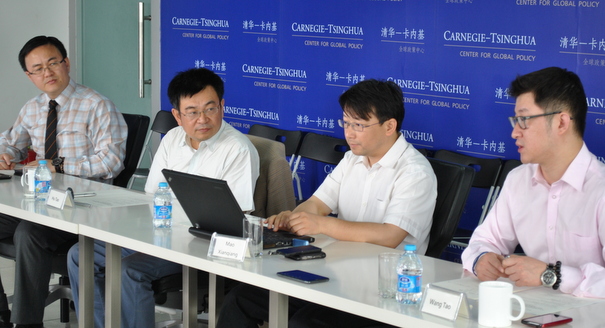Registration
You will receive an email confirming your registration.
IMGXYZ3959IMGZYXAs China’s economy grows, an increased need for energy to fuel this growth has resulted in an insatiable demand for coal. Coal now accounts for 80 percent of China’s power generation, resulting in a visible increase in pollution. In 2009 coal-burning plants alone produced 9.48 million tons of sulfur dioxide, 8.65 million tons of nitrogen oxide, and 2.787 billion tons of carbon dioxide. In addition, the singular focus on end-of-pipe solutions for pollution reduction has ignored the production of other pollutants, resulting in an overall net loss on pollution mitigation.
Carnegie’s Wang Tao hosted a roundtable discussion to discuss solutions to carbon and pollution emissions. Wang was joined by Hu Tao, senior environmental economist at the Ministry of Environmental Protection’s Policy Research Center, Mao Xianqiang, professor at Beijing Normal University’s School of Environment, and Carnegie’s Kevin Tu.
The Danger of Overemphasizing Carbon Reduction
- Distraction from Other Pollutants: The scholars agreed that an overemphasis on carbon reduction has distracted policymakers from the need to mitigate other pollutants that directly impact public health, such as nitrogen and sulfur. Hu expressed skepticism that carbon reduction initiatives automatically reduced these other pollutants.
- Impact on Public Health: Overemphasis on carbon mitigation and end-of-pipeline measurements, such as smokestack scrubbers and flue-gas desulfurization, can create even more health problems than they resolve, panelists said. Hu gave the example of how the production of photo-voltaic panels in Baoding was highly energy intensive. The production of these panels created more carbon emissions than the carbon emissions that were supposed to be reduced by using them.
Proposed Solution of Co-Control and Co-Benefits
- Installing Front-of-Pipeline Measures: Adding front-of-pipeline measures to the current end-of-pipeline solutions would allow for co-control of all pollutants and greenhouse gas emissions, panelists suggested. This mix of front and end-of-pipeline solutions, called co-control, would also maximize the benefits of pollution reduction. These produce co-benefits, in which the reduction of one pollutant will result in a reduction of a different pollutant. According the panelists, co-control measures include coal-washing, low nitrogen combustion technology, air preheater retrofitting, high voltage frequency conversion, and retrofitting steam seals for steam turbines.
- Considering the Costs of New Measures: When choosing pollution mitigation plans, Mao considered both total pollution reduction and costs. Technologies should be cost efficient and be viewed in a holistic manner that considers controls for all pollutants, he explained. The scholars emphasized that each program should be measured across a range of Unit Pollutant Reduction Costs--a ratio of pollution reduction to costs--to decide which projects to implement.
- Structural Adjustments Also Needed: In addition, Mao highlighted the necessity of structural adjustments to China’s energy sector so that the country is less dependent on coal burning plants. These structural adjustments could include developing hydro, solar, wind, and nuclear power, which produce far less carbon and polluting emissions compared to coal-burning plants.
China’s Challenges to Emission Reductions
China faces numerous environmental challenges of a technical, organizational, and political nature. At the same time, it continues to face two pressing climate change issues: the optimization of the various climate and energy targets to produce maximum benefits, and the consolidation and enhancement of China’s energy and environmental oversight mechanisms. Tu noted that even structural adjustments, such as nuclear, hydro, solar, wind, and natural gas infrastructures, have their trade-offs. There are issues of safety, environmental destruction, efficiency, and investment that should be considered. He further emphasized that the management of China’s energy industry is fragmented, with the best solution being the creation of a super-ministry to oversee China’s energy industry. However, such a restructuring will face resistance from existing ministries unwilling to relinquish control of their sectors.
